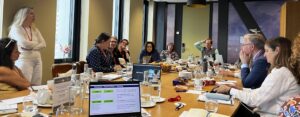by Ken Kahtava, FSHD Society
This blog post was originally published here on the Project Mercury website.
On 11 May in Leiden, NL, the Project Mercury global task force members met for the first time to chart the path forward for achieving the program’s aims. In a world that thrives on individuality and competition, it’s easy to overlook the remarkable strength that lies in collaboration. The power of collaboration represented in the task force extends far beyond what any single person or organisation can achieve on their own. This was on full display in Leiden as task force members combined their unique perspectives, talents, and skills, unlocking a wealth of possibilities that seemed insurmountable alone.

In this blog post, we look to provide everyone a view of why global collaboration lies at the very heart of Project Mercury.
Amplifying Ideas:
Collaboration in Project Mercury acts as a catalyst for creativity and innovation. At the task force meeting table, people from multiple countries, diverse backgrounds, disciplines, and experiences converged, ideas collided and expanded in ways that every member of the task force agreed would be impossible to achieve in isolation. Represented at the table were:
- Patients
- Advocacy organizations
- Leading FSHD clinicians
- Biopharma companies
- Clinical trial networks
- Patient registries
- Clinical and patient education experts
- Experts in health economics and patient access
Project Mercury is a global initiative. While the member roster of the global task force continues to grow, at the inaugural meeting, members represented multiple countries and cultures, including:
- Australia
- Canada
- France
- Germany
- The Netherlands
- United Kingdom
- United States
Each person brought their own set of expertise and viewpoints to the table, allowing for the development of focused and robust solutions to the complex problems Project Mercury addresses.
Fostering Global FSHD Synergy:
The global task force is greater than the sum of its parts. The task force determined that by pooling resources, sharing responsibilities, and leveraging each other’s strengths, we will achieve remarkable feats in Project Mercury. The shared sense of purpose and collective momentum is already propelling Project Mercury forward, inspiring confidence in our mission to overcome obstacles and deliver on our promise to speed therapies into the hands of people effected by FSHD.
Learning and Growth at Global Scale:
The meeting proved to be fertile ground for learning from one another, expanding our knowledge, skills, and perspectives. We gained exposure to different working styles, problem-solving approaches, and communication techniques, broadening our horizons and fostering adaptability. There was a spirit of continuous learning, where feedback and constructive criticism drove improvements throughout the day on the strategies necessary to success.
Building Stronger Relationships:
A cornerstone of Project Mercury is strong relationships. Working together towards shared goals has begun to foster a sense of trust, respect, and camaraderie among task force members. As these connections deepen, the teamwork, empathy, and understanding that is critical to delivering Project Mercury’s objectives emerges. These relationships extend beyond Project Mercury, creating a network of support and collaboration that can have long-lasting benefits for FSHD.
Conclusion:
Collaboration is not just a buzzword for Project Mercury; it is a transformative force that fuels progress, innovation, and growth – all essential ingredients to Project Mercury’s success. By embracing collaboration, the global task force is tapping into a vast pool of collective intelligence, amplifying ideas and expanding horizons. Collaboration fosters synergy, propelling us to achieve more together than we ever could alone. It nurtures relationships, promotes learning, and equips us to tackle complex challenges to speeding delivery of effective therapies in FSHD around the world. We recognized and harnessed the power of collaboration in the inaugural meeting of the global task force, and it holds the key to a brighter future for everyone effected by FSHD. Soon to come is the first guidance document from the Project Mercury global task force – stay tuned!
For more information, visit the Project Mercury website.


It is inspiring to read that such a group, such as yourselves, are know starting to collaborate with each other on a unified goal in finding ways to eliminate the effects of FSHD. I am now 66 years old and have had this disease for most of my life. This seems to be an opportunity to gain more insight on how to cure this disease!
I wish you good luck in your search and …. God speed!
Andre O’Bumsawin
Lindsay, Ontario, Canada